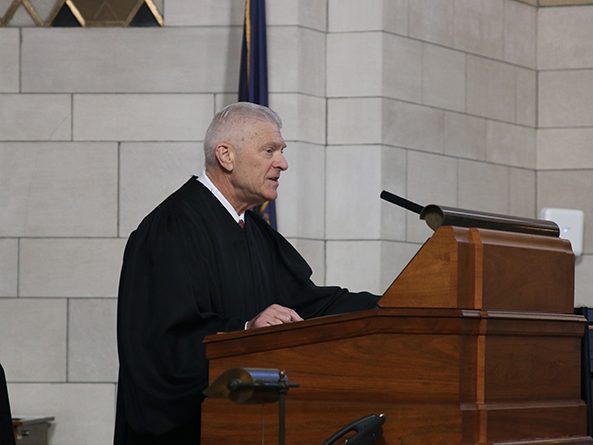Chief justice points to success of new court programs
The head of the state’s judicial branch reported on its work to make the state’s court and probation systems more effective in a time of constrained state budgets in his State of the Judiciary address Jan. 18.
“We are constantly asking ourselves: Is there a way to do this better?” said State Supreme Court Chief Justice Michael Heavican. “And, indeed, this body has asked us to find ways to do it better.”
He said the judicial branch has responded in recent years by creating problem-solving courts, specialized probation programs, the Office of Public Guardian, probation-led juvenile justice supervision, electronic case management and other initiatives.
Heavican highlighted the state’s two new veterans’ treatment problem-solving courts, which use judicial and probation supervision and trained veteran mentors to help veterans with substance abuse or mental health problems rejoin society.
He said the judicial branch also is beginning to implement re-entry courts, which provide additional supervision to those released from prison. Those courts are a response to the Legislature’s Justice Reinvestment Initiative, Heavican said, which is aimed at providing supervision of Class III and Class IV felons after they are released from state or county correctional facilities.
Heavican said Nebraska has nearly 18,000 people in its adult probation program, an increase of approximately 1,400 since 2016—an indication that judges and probation officers are following the Legislature’s directive. He cited a University of Nebraska-Lincoln study, which found that the recidivism rate for adult probationers in Nebraska is approximately 15 percent.
“Fifteen percent is an extraordinarily good number based on adult probation standards,” Heavican said. “Your investment in probation is paying off in both tax dollars and public safety.”
He said demand for increased probation services and specialty courts is high, but proposed budget cuts will reduce probation services and capacity.
The state’s juvenile justice system, too, is showing success with a decreased recidivism rate, Heavican said. UNL found the rate of recidivism for a one-year repeat of delinquent or criminal behavior to be approximately 25 percent.
Heavican also noted the success of a new restorative justice pilot program in Scotts Bluff, Douglas and Lancaster counties, which has so far served more than 200 youth, their parents and victims of their delinquent behavior. Participants in the program must admit their misbehavior, agree to a rehabilitation program and meet with their victims. He said the program is being expanded to include Adams, Buffalo, Dodge, Gage and Saunders counties.
“Nearly all program participants, including victims, youth and their parents, have expressed satisfaction with the program,” he said.
Heavican urged lawmakers to read the Office of Public Guardian’s annual report released earlier this month. He said the office, which appoints guardians for vulnerable adults and developmentally challenged individuals, handled 237 cases in the last year, and its 264 wards have many challenging issues, including cognitive impairment, mental health problems, developmental disabilities and substance abuse. Assistant public guardians have full or overflowing caseloads, he added, and the state Supreme Court has set up a waiting list procedure.
Finally, the chief justice reported on the increasing use of technology in Nebraska’s court system. The state recently updated its electronic payment system, he said, making it easier for businesses to pay garnishments and for people to pay probation fees, court fines or civil judgments. He said the probation system also is implementing electronic delivery of presentence investigation reports across the state.
All of these programs prove the judicial branch’s commitment to an open and fair court system while working within its budget, Heavican told lawmakers.
“Mindful of the budget constraints of the last year, and the likely budget constraints of the near future,” he said, “the courts continue their dynamic pursuit of ways to do our job better.”


